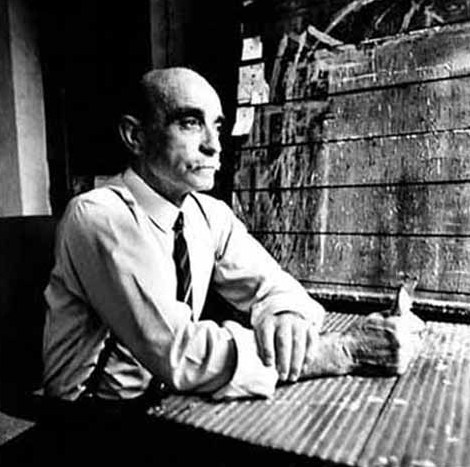
Lucio Fontana
Lucio Fontana is renowned as a founder of Spatialism. His association with Arte Povera firmly establishes him as a monumental figure during this era of great artists.
Biography of Lucio Fontana
Lucio Fontana's life began in Argentina, where his parents resided—Luigi, a sculptor, and Lucia Bottino, a theater actress.
Fontana went to Italy for his education when he reached school age and stayed there until his college years. In Milan, he attended the master-builders school at the Carlo Cattaneo Institute while actively practicing art.
Despite his promising career as a young artist and scholar, Fontana chose to volunteer as a soldier in World War I in 1916, temporarily interrupting his studies. Despite his lack of military training, his intelligence and talent led him to achieve the rank of second lieutenant in the infantry regiment. An injury sustained during the war brought him back to Milan, where he was fortunate enough to resume and complete his studies, continuing his artistic endeavors. In recognition of his wartime contributions and service to his country, he received a silver campaign medal in 1918.
The years following Fontana's return from the battlefield were characterized by his deep exploration of his inner artist. This exploration unfolded in both Italy and Argentina, and it's possible that his diverse heritage and time spent on both continents played a pivotal role in shaping his innovative and exploratory artistic approach.
Fontana returned to Argentina in 1921 and worked in his father's studio, primarily creating graveyard sculptures. Simultaneously, he conducted experiments and research to discover new styles and forms. After several successful years of such practice, he enrolled in the sculpture course at the Brera Academy of Fine Arts and earned his diploma by presenting his work "El Auriga" (The Charioteer).
During the 1930s, his sculptures took on human-like figures, which were stripped of their conventional forms and reduced to geometrical shapes, as seen in his 1930 creation, "Uomo Nero" (Black Man). His exploration of form led Fontana to produce abstract sculptures in ceramics and even colored mosaics in the early 1940s. This culminated in his first work in environmental art, "Frieze Volo Di Vittorie," symbolizing the Flight of Victories.
In 1946, the term "Spatial Concept" appeared as the title of a series of drawings created by Fontana. After returning to Italy following his tenure as a professor at the Esquela de Artes Plasticas in Argentina, Fontana, along with other philosophers and writers, supported the first manifesto of Spatialism. He had previously formulated various theories on the subject. Spatialism aimed to expand artistic practice beyond mere narrative, placing a strong emphasis on the space surrounding the canvas and incorporating additional technologies like neon lighting and television to give the artwork another dimension.
Notably, between 1963 and 1964, Fontana produced a series of famous oval paintings titled "The End of God," one of which, "Concetto spaziale, la fine di dio," sold for over $29 million at an auction in 2015.
Lucio Fontana's artistic oeuvre not only embodies captivating visual aesthetics and thought-provoking elements but was a transformative movement that revolutionized the perception of art pieces. His creative and explorative practice led to the invention of a novel philosophy that transcended the realm of art, even during an era of legendary artists, cementing his status as one of the greats of his time.
Lucio Fontana's Art Style
Lucio Fontana's work was significantly influenced by the "Spatial Concept." Whether working with sculpture or painting, his focus often revolved around portraying dimensionality through various deliberate punctures and gashes.
Some of Fontana's initial expressions of Spatialism were seen in his slashing series, which included two distinct approaches to dimensional representation: "Buchi" (holes) and "Tagli" (slashes). These punctures on the surface of the paintings would unveil the space behind them, often lined with black gauze, creating a sense of depth as the darkness of the material emanated from the holes. Around 1958, Fontana shifted to monochromatic surfaces that further emphasized the space within and beyond the canvas.
In the later years of his prolific career, the 1960s, Fontana's art evolved to include thick layers of oil paint punctured with holes. This period culminated in the strict use of single colors for his canvases in the "Ellipses" series. He also delved into sculptural work inspired by New York, consisting of metal plates that he punctured himself. In these later years, he even employed machines to perforate the wooden panels of his paintings, staying in line with new technical developments.
Years:
Born in 1899
Country:
Argentina, Rosario, Santa Fe
Gallery:
Galleria d'Arte Maggiore g.am.
Van de Weghe
Helly Nahmad Gallery
Galerie Karsten Greve
Galerie Knoell
A arte Invernizzi
Vedovi Gallery